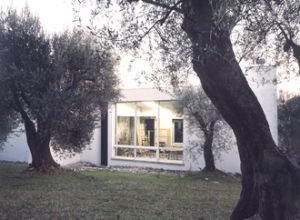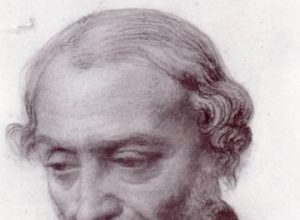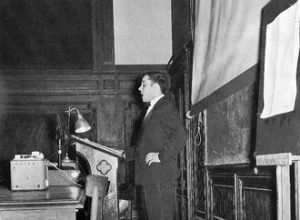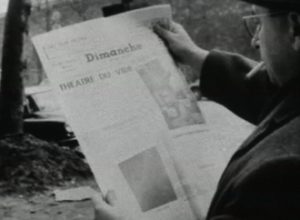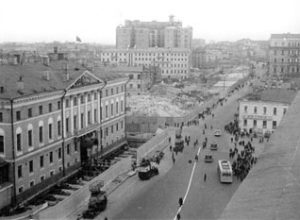Under the heading of the battles led in favor of equality for all in cultural matters, the name of Gaëtan Picon may be mentioned, as we are told by Agnès Callu, the author of a dissertation about this man, one of “history’s vanquished.” Picon is said to have consistently tried to impose an elitist form of taste via the loftiness of choices that were not only audacious but democratic, in that he campaigned so that the whole of the country would be reached, in particular by means of French-style community arts centers, the Maisons de la Culture. A French Nietzschean and a solitary figure who ultimately remained at the margins of contemporary discussions, Picon is said to have, despite all, left behind faint traces of a far-reaching project, one first imagined as early as 1937 and put into practice (but also impeded) when, starting in 1959, he served as Director for Arts and Letters under the ministry of André Malraux.
Laurence Bertrand Dorléac
Gaëtan Picon
Agnès Callu
Gaëtan Picon (1915-1976), who is remembered for his intense and difficult writings that analyzed, explained, and interpreted complex conceptual objects, remains in the collective imaginary someone who is, if not unknown, at least vaguely labeled among “history’s vanquished” (as some have said). And yet, he basically was a man who thought about culture, an advocate of elitism for all who passionately campaigned for “culture, the collection of things to which we are attached, which we prefer, which we love.” In a roundabout way, one certainly intended to celebrate his actions in the Cultural Affairs office during a colloquium for the fiftieth anniversary of the creation of the French Ministry of Culture, when the various models for cultural policy were recalled and Bernard Faivre d’Arcier highlighted André Malraux’s initiative to impose “a working humanistic and republican way of thinking that issues directly from the Age of the Enlightenment.” Again obliquely, the constant dependability of his taste for contemporary art was recognized at the time of the retrospective organized around the work of “the painter of black,” Pierre Soulages. However, a research program designed specifically to set Gaëtan Picon at the epicenter of historical research was long awaited and may now be considered an academically admissible option.
Gaëtan Picon, One of “History’s Vanquished”?
First, in an immediate reading, one would have to question why, still today, Picon is left in the shadows. Why, indeed, have there been so few–indeed, very few–studies about him? Has there been an intentional ostracization of a critic or novelist deemed to be situated beneath those genres and/or punching below his weight? Or has there been an inevitable ostracization, considering the repellent effect of an almost unreadable form of expression and style wherein poetry and philosophy contend, on the field of language, in their efforts to question objects that themselves have been rendered inaccessible? Has there been an ostracization because, on the whole, both the man and his thought advanced against the then-environing ideas and ideologies? For, he was indeed far removed from postwar Sartrean Existentialism and an anti-Structuralist–nay, an “a-Structuralist”–during a decade (the Sixties) that was admiring of new intellectual configurations when they were Foucauldian in character. This is why, understanding the isolation and/or rejection of a thinking and acting subject, an author of a body of work that, despite all, was always well-referenced and, on certain levels, remained referential, constitutes, for the historian, in itself a valid and valuable field of study.
Secondly, Picon’s (intellectual as much as behavioral) transversality suggests, de facto, a multidisciplinary approach to work that is stimulating yet still barely granted and confirmed historiographically. With his “philosophical attitude,” his poetic language, and the sensualist eroticism of his genetic analysis of works, Picon stands at the crossroads of several researcher profiles. To interpret him and his works, he demands that one, if not eliminate, at least agree to render porous, the boundaries between several academic disciplines. Without even speaking of the psychological dimension, “getting into his head” requires that one call upon references and tools that borrow from the historical and literary sciences but also, to a great extent, from Philosophy and Aesthetics.
Thirdly, Picon’s “apolitical attitude” is intriguing. Of course, his romantic attachment to the Left at the time of the Spanish Civil War, his rejection of various forms of totalitarianism during the 1939-1945 period, and his decision to support Gaullism at the time of the Liberation all border in a low-key sort of way(in his mind alone) on militancy, though without his ever having truly taken any sort of militant stand. Leaving aside the oversimplifications involved in generalizing about generational paths, it is true that one could have expected that an “intellectual” like him might have committed himself during World War II, might have taken a position at the time of the Algerian War, and might, as a decision-maker under the Gaullist regime, have followed the General’s ideals and taken his side in 1968. So, what are the reasons why Picon remained, if not evasive, at least in constant flux, at the margins of all forms of politicization? An interpretation that would depict him as a man without a political conscience or as someone who subordinated it to current trends and circumstances is illusory, just as wanting to classify him within, almost to divide him into, one or several political families is basic nonsense. Why? Because Picon was, in his underlying temperament, a philosopher. Beyond immediate circumstances, he lived, valued, and belittled his life and times as a philosopher, and his Nietzscheanism placed him in an “u topos” that did not curb his conscience (which was clear) but instead lastingly positioned it above politics, as if looking down upon it. He looked upon and analyzed politics from above, in his ivory (or paper) tower: 1936, the Defeat, the Rally of the French People (RPF) with its de Gaulle as liberator, the missed opportunity, according to him, for salvation in 1968, when, dusting off the old icons of a staid bourgeoisie, the times would have allowed what Picon, an idealist isolated from the world, its contingencies, and its realities, ultimately never stopped hoping for, from the age of 17 to the age of 60–the emergence of a “new order” open to free men.
Writing the Biography of an Intellectual
Also, delving into the unexpected aspects of a sometimes winding, but in truth linear, career path goes to justify this effort. Why did Picon write about authors and artists who were concurrently classic and underground (Honoré de Balzac and Jean Dubuffet, for example)? Why did Picon, anchored to the Nietzscheanism that alone he accepted, reject the label intellectual so as to follow his tastes that went in arabesques from Literature to the Visual Arts, going by way of a few musical passages? Why does the figure of Picon the philosopher, removed from real time but bumping up against some demanding temporal markers that required one to choose, become disturbing as soon as that figure begins to look like a kind of withdrawal, a sort of contempt, whereas it was merely ethical and respected watchful detachment? All these questions are worthy of examination. Yet they make sense only on the condition that they are plainly linked together in the élan of a personal and biographical trajectory. Understanding a work is obviously to understand he who produces it. As one knows, one must dig deeply into the individual’s social, cultural, intellectual, political, and economic foundations. More specifically, this requires that one identify what that individual has inherited and onto what it has been grafted, the construction of referents, the emergence of talent, the invention of emotional substitutes, the range of ties that express his heart’s desires, his flaws, too, his place in society, the circles he frequented and the places he socialized, and how he navigated within a milieu which, between 1945 and 1970, hardly considered the notion of a Republic of Letters anachronistic and wherein he who was almost always called “Gaëtan” was, all at once, happy, sad, an addict, lost, melancholic, and enthusiastic.
A Biography for Understanding a Cultural Policy
Working on a biography of Picon is a useful exercise because, beyond the analysis of a “plural narrative identity,” what is really at issue is the study of an inventive and innovative cultural policy. Such a biography takes on breadth and meaning, however, only when examined, as a matter of fact, on the scale of a life considered over the long term [sur la longue durée].
On account of a friendship with André Malraux based on mutual admiration which remained interrupted from 1934 onward and the decisive “shock” he felt upon reading Man’s Fate, Picon found himself, in 1959, in a decision-making role. As one knows, when Malraux became Minister of Cultural Affairs, he called upon Picon to occupy the key post of Managing Director for Arts and Letters. Here we have not a mere pro-Gaullist political appointment, no “Republic of Buddies” to aid only “Gallimard authors,” but instead an acute awareness, on Malraux’s part, that Picon was “a man who thought Culture” for going on thirty years. Also, the offer of a post in no way corresponded, for Malraux, to some sort of “golden parachute” offered to a friend who was perhaps somewhat stuck in a professional impasse, but instead to a real strategic choice at a time when it was a matter, along with a sort of “intellectual twin,” of laying the foundations for a new cultural policy.
Moreover, Malraux knew exactly what he was doing. For, since the late 1930s, he was the privileged eyewitness to the construction of Picon’s concept of culture. And he had followed his friend as early as 1937 in the difficult notional triangulation the latter was sketching out between Culture, Knowledge, and Civilization, to which he remained attached his whole life long–was this a sort of fixation or some kind of fidelity to principles?–for it was inhabited, motivated, and clarified by Nietzsche. During the War, Malraux followed step-by-step the progress of Picon’s posthumously published philosophical essay “Truth and Myths,” which shifted his concept of culture to take into account the traumas brought on by this conflict. Ten years later, in 1951, beyond the same stirrings of emotion for “the psychology of art” and “an imaginary museum,” Malraux feverishly shared with Picon, in Beirut, the contours of a proto-Ministry and already, in their galloping imaginations, the premises for French-style community arts centers, the Maisons de la Culture. The following year, he heard Picon speak at the Congress for Cultural Freedom for the first time with conviction and convincingly in favor of a kind of culture that was already Malrucian in character, because founded again around a historical heritage. That is why, in 1959, Malraux’s extension of an invitation to Picon went well beyond just helping out a friend. And Picon’s intellectual breadth, which gained public recognition with his two Panorama volumes, does not suffice to explain his appointment. Malraux knew that his philosopher friend was going to inspire and offer perspective for the implementation of a kind of Culture both hoped would be genuinely contemporary in character. Of course, Picon settled into his job in a way that Malraux had not foreseen. But is that not always the case when hierarchy comes to unsettle relationships based on friendship, reassigning roles no longer along the horizontal lines of mutual affection and intellectual understanding but in a vertical hiatus between the order-giver and the executant? Now, in his arrogant rectitude, Picon firmly rejected the change. Standing aloof from the Cabinet and from the plottings, court intrigues, and various habitus of cultural administration, he remained faithful to himself, all of a piece. His role, as he conceived it, was simply to be a scholarly advisor right at Malraux’s side. But the latter, broken by his personal pain and grief, removed from his writing practice, cut off from the world by an entourage that was jealous of his original bond with Picon, and strongly committed to de Gaulle, became irritated with the rigidity of Picon, who remained unchanging in his attitude and obstinately rejected the rules of a social and bureaucratic game he deemed a curb on his freedom of expression. Here we find the true tension. For, on basic issues, the two friends were both gazing in the same direction: they shared the same outlook regarding the Museum of Modern Art, the same outlook in favor of the iconoclastic artist Jean Dubuffet, the same outlook in support of Pierre Boulez and his creative Institut de Recherche et Coordination Acoustique/Musique (IRCAM). It is just that the most direct sort of noxious pressures emanating from the political and social environment–which militated in favor of the lowest common denominator, supposedly capable of rallying people together–made Malraux back down. In choosing people like Pierre Moinot and Marcel Landowski, he made gestures in favor of a measured policy directed toward citizen education. Yet Malraux knew that he was going against his own interests. To speak only of that emblematic structure, the underground section of the “Grand Louvre,” which was later to be orchestrated by the building duo of Émile Biasini and I. M. Pei, Malraux, by disavowing Henry Seyrig in the early 1960s, knew that he was neglecting his quite promising initial views, which had been worked out one summer evening in 1952 by himself, Picon, and the aforesaid Seyrig in the oriental gardens of Beirut’s École Supérieure des Lettres. Also, it appears that the social tensions that are automatically generated within all organizations, and which were especially violent in a Ministry of Cultural Affairs that was then under construction and in search of an identity of its own, won out over the friendship between the two men who had never truly advanced any ideas that were really in mutual contradiction. Of course, using the nuances of a color chart, it can be said that the cultural outlook of each was slightly different. Yet it would be wrong to play up an opposition between the two on the level of principles. Their divergences were situated on the terrain of intellectual discussions and not on the bedrock of their respective orientations. The aesthetic of both men combined Philosophy of History with Humanism. Certainly, their conceptions of modernity differed: Malraux extolled the present for what it had of eternal value while Picon underscored its capacity to anticipate the future and its promise of things to come. Nevertheless, both militated in favor of a kind of contemporary culture that would be elitist, on account of the demanding nature of its creative choices, yet democratic, since the intention was to irrigate the whole Hexagon through a network of community arts centers that would permit the public, as Biasini recalled, “to encounter there, concurrently, Molière, Braque, and Debussy.
Upon Picon’s death, the critic Jacqueline Piatier referred to him via the lovely circumlocution “Picon, or the essence of beauty.” Picon did indeed situate himself at the cardinal point of Aesthetics and Culture. A sensualist, he was well versed in looking, touching, smelling, and sniffing out works, and it was this taste for the Arts that, prophet-like, he intended to set at the heart of his cultural policy. Jacques Bersani and so many others associated him with the acuity of a “lookout” for his “breakthrough,” inventively “revealing” reading of the work, of course, of Malraux, but also, far ahead of others and well before them, the poetry of René Char, the poetics of Pierre Reverdy, the highly difficult writings of Maurice Blanchot, the “continent” of Dubuffet, and the “cry” of Francis Bacon. What was his problem? His isolation, the disastrous consequences of which, he admitted, he suffered each day.
Solitary by temperament, disdaining a legalistic strategy, faithful to his authors and to his artists at the risk of forgetting other ones, isolated by the indecipherable yet still sublime abstractness of his writing style, he always fled away from trends, loving an elementary intellectual particle in one without subscribing to all of the opinions of another. Only tangentially related to networks of people, he was occupied for a moment with some reviews, but never did he espouse, in general, an intellectual line drawn by anyone other than himself. Torn between the safety of a choice he deemed the best (whose perimeters he had almost completely delimited by his early twenties) and the chronic doubt that made him think that he might be mistaken or might have stayed below his “Himalayan literary giants,” he remained “off camera”: he was “a-generational,” “a-political,” and this “a-” of his could be made into a model. Never at the center, always at the margins, he did not succeed in entering into the discussion of the ideas of his time, which is where his excellent judgment should nevertheless have led him.
Bibliography
L’œil double de Gaëtan Picon, Paris, Centre Georges Pompidou, 1979.
“Entretien entre Gaëtan Picon et Cella Minart sur France Culture en 1975”, dans le Mercure de France, MCMLXXIX, 1979, pp. 11-71.
Guy MARTINIÈRE (dir.), Gaëtan Picon : de l’aventure littéraire à l’action culturelle, Paris, Les Indes savantes, 2007.
Collectif, D’un art à l’autre : l’oeil double de Gaëtan Picon, Paris, IMEC/Bonfanti, 2011, [coffret/livret multimedia].
Agnès CALLU, Gaëtan Picon (1915-1976) : Esthétique et Culture, [préface de Jean-François Sirinelli et postface d’Yves Bonnefoy], Paris, Honoré Champion, 2011, 714 p.
A former student at the École Nationale des Chartes (thesis published on the French Union of National Museums under the French Third Republic; recipient of the Lenoir Prize) and of the French National Heritage Institute (class of Hubert Robert) with a doctorate in contemporary history from Paris’s Institute of Political Studies (thesis published on the philosopher-aesthetician Gaëtan Picon, 1915-1976), Agnès Callu is a historian, a heritage curator at the French Museum of Decorative Arts in charge of the Graphic Arts Department, an associate researcher at the French National Center of Scientific Research (CNRS)’s Institute of the History of the Present (IHTP), a fellow at the University of Paris-Sorbonne (Paris IV) and at Sciences-Po Paris, as well as a junior lecturer at the École Pratique des Hautes Études (EPHE). Her work on Gaëtan Picon received the Chaix d’Est Ange Prize from the French Academy of Moral and Political Sciences in 2011.
